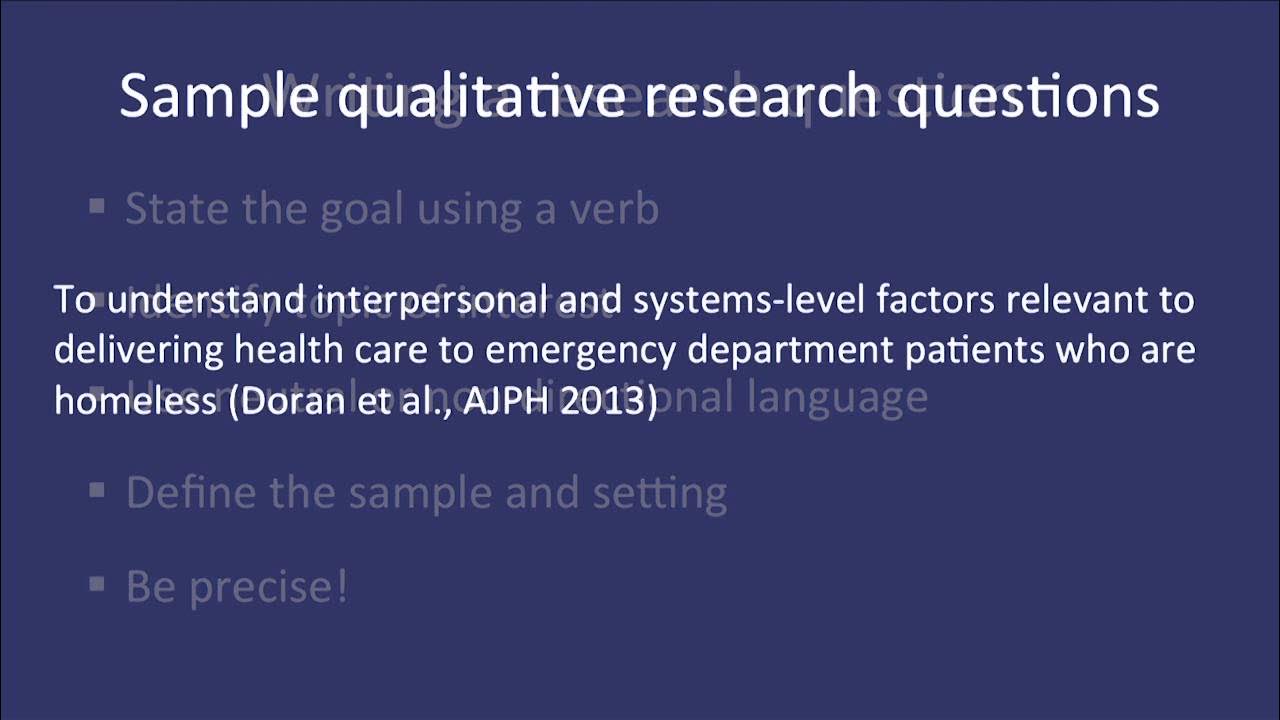Fundamentals of Qualitative Research Methods: Data Analysis (Module 5)
Summary
TLDRLeslie Curry from the Yale School of Public Health presents an insightful overview of qualitative data analysis (QDA) in health research. She emphasizes the iterative nature of QDA, highlighting the importance of both individual and group interpretations of narrative data. Key concepts include the definition of codes as representative phrases, the structure and evolution of code frameworks, and approaches to developing these structures. Curry also discusses the role of software in enhancing efficiency and transparency, while cautioning that qualitative analysis is time-consuming and requires a collaborative, multidisciplinary effort. Overall, she advocates for a meticulous and flexible approach to coding and analysis.
Takeaways
- 😀 Qualitative data analysis is an iterative process involving both individual and group interpretations of narrative data.
- 😀 A code is a word or short phrase that captures the essence of narrative or verbal information, aiding in categorization.
- 😀 The code structure evolves throughout the analysis, often undergoing multiple revisions to refine codes and their definitions.
- 😀 There are three main approaches to developing a code structure: purely inductive, start list, and integrated approaches.
- 😀 The inductive method emphasizes deriving codes directly from participant experiences, while the start list method introduces preliminary codes based on prior knowledge.
- 😀 The integrated approach combines both inductive and deductive methods, enhancing the coding process's efficiency and precision.
- 😀 Using software for qualitative data management is essential for organizing large amounts of data and ensuring transparency in the research process.
- 😀 Qualitative data analysis is labor-intensive and requires multidisciplinary teamwork, allowing for diverse perspectives in data interpretation.
- 😀 The constant comparative method involves ongoing revisions of the code structure based on new data, ensuring comprehensive analysis.
- 😀 Documenting the analysis process, including the creation of audit trails, is crucial for maintaining transparency and rigor in qualitative research.
Q & A
What is the main goal of Leslie Curry's series on qualitative research methods?
-The main goal is to enhance the capacity to conceptualize, design, and conduct qualitative research in the health sciences.
What is a defining feature of qualitative data analysis according to the transcript?
-Qualitative data analysis is characterized as an iterative process involving individual and group-level review and interpretation of narrative data.
What is the definition of a 'code' in qualitative analysis?
-A code is a word or short phrase that represents the essence or key attribute of narrative or verbal information.
How does Leslie Curry suggest developing a code structure?
-A code structure is developed through the identification of emerging codes, which are organized hierarchically and refined over the course of the analysis.
What are the three approaches to developing a code structure mentioned in the transcript?
-The three approaches are: 1) Inductive grounded method, 2) Start list method, and 3) Integrated approach.
Why is it important to have a manageable number of codes in a study?
-Having too many codes can make analysis unmanageable; a smaller, more focused set of codes is easier to navigate and contributes to more effective analysis.
What role does software play in qualitative data analysis?
-Software is used for data management and organization, enhancing efficiency and supporting transparency in the research process.
What is the 'constant comparative method' mentioned in the analysis process?
-The constant comparative method involves moving back and forth between emerging data and the existing code structure to ensure all ideas are accommodated.
What does Leslie Curry caution about the use of software in qualitative analysis?
-Curry warns that while software supports analysis, it does not conduct the analysis itself; the effectiveness of the analysis depends on the research team's engagement and debate.
What is the key takeaway regarding the nature of qualitative data analysis?
-Qualitative data analysis is labor-intensive, requires a multidisciplinary approach, and is iterative, making it fundamentally different from quantitative analysis.
Outlines

Dieser Bereich ist nur für Premium-Benutzer verfügbar. Bitte führen Sie ein Upgrade durch, um auf diesen Abschnitt zuzugreifen.
Upgrade durchführenMindmap

Dieser Bereich ist nur für Premium-Benutzer verfügbar. Bitte führen Sie ein Upgrade durch, um auf diesen Abschnitt zuzugreifen.
Upgrade durchführenKeywords

Dieser Bereich ist nur für Premium-Benutzer verfügbar. Bitte führen Sie ein Upgrade durch, um auf diesen Abschnitt zuzugreifen.
Upgrade durchführenHighlights

Dieser Bereich ist nur für Premium-Benutzer verfügbar. Bitte führen Sie ein Upgrade durch, um auf diesen Abschnitt zuzugreifen.
Upgrade durchführenTranscripts

Dieser Bereich ist nur für Premium-Benutzer verfügbar. Bitte führen Sie ein Upgrade durch, um auf diesen Abschnitt zuzugreifen.
Upgrade durchführenWeitere ähnliche Videos ansehen

Fundamentals of Qualitative Research Methods: Developing a Qualitative Research Question (Module 2)

Fundamentals of Qualitative Research Methods: Focus Groups (Module 4)

Fundamentals of Qualitative Research Methods: What is Qualitative Research (Module 1)

Konsep Dasar Biostatistik

Qualitative Data Analysis 101 Tutorial: 6 Analysis Methods + Examples

Introduction to Epidemiology: History, Terminology & Studies | Lecturio
5.0 / 5 (0 votes)
